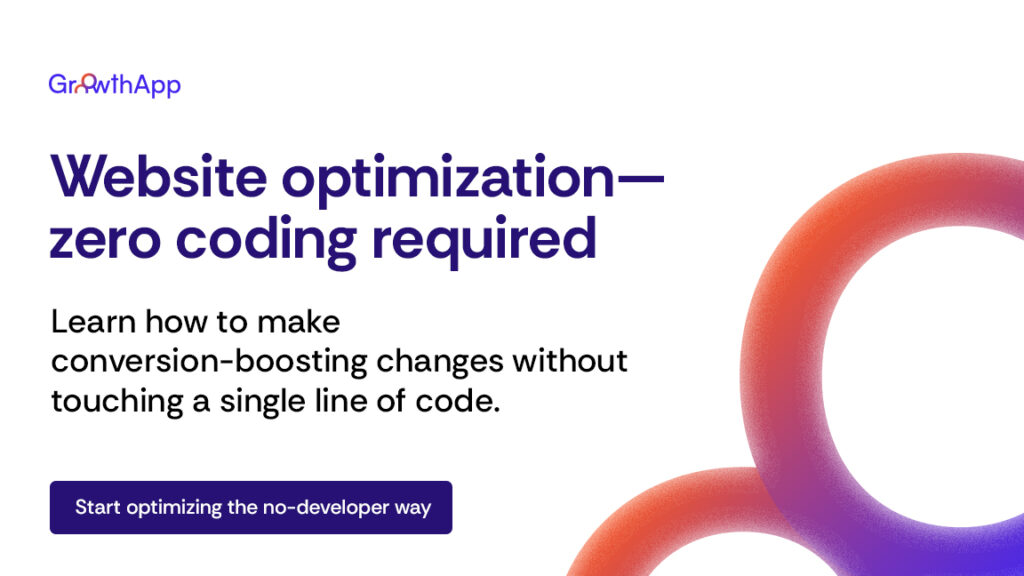No matter how beautifully designed your website is, if it’s not optimized for conversions, you’re leaving money on the table. And here’s the frustrating part—most business owners assume that boosting sales through their website requires a developer, someone who can dive into complex code and make technical magic happen.
But that’s not entirely true.
There’s a growing movement toward no-code optimization techniques that allow business owners, marketers, and even solopreneurs to improve their website’s performance without touching a single line of code. Thanks to a wide range of free CRO tools and simple sales optimization strategies, you can tweak your website to drive more leads, increase conversions, and ultimately, boost revenue—all without hiring a developer.
And this isn’t just theoretical. Companies that focus on Conversion Rate Optimization (CRO)—the process of refining a website to maximize the percentage of visitors who take action—see significant improvements in their bottom line. According to a study by Econsultancy, businesses that prioritize CRO are twice as likely to see a large increase in sales compared to those that don’t. Meanwhile, research from Forrester shows that a well-optimized website can lead to a 200-400% increase in conversion rates over time.
The key is to focus on what needs fixing, not how to code the fix. Whether it’s speeding up your site, improving mobile responsiveness, or testing different headlines, the tools and data you need are more accessible than ever.
So, if you’ve been struggling with low conversions, high bounce rates, or underperforming sales pages, it’s time to take control. Below, I’ll walk you through practical, no-code techniques that will help you optimize your website for more sales, backed by proven strategies and real-world case studies.
1. Speed up your website without a developer
Page speed is one of the most overlooked factors in conversion rate optimization. A slow website kills sales—visitors won’t wait around for a sluggish page to load. If your site takes more than a few seconds to appear, potential customers will leave before they even see your products or services.
According to Google, a one-second delay in page load time can reduce conversions by up to 20%. And in today’s instant-gratification world, people won’t wait around for a slow website.
Why speed matters
Google research shows that when a page load time increases from 1 second to 3 seconds, the probability of a user bouncing (leaving the site) increases by 32%. If it reaches 5 seconds, the bounce rate jumps to 90%.
A slow website doesn’t just frustrate users—it also hurts your search engine rankings. Google considers page speed as a ranking factor, meaning a slow-loading site could get pushed lower in search results, making it harder for potential customers to find you.
How to improve speed without coding
You don’t need a developer to fix speed issues. There are free tools that analyze performance and suggest improvements:
- Google PageSpeed Insights – Provides a detailed breakdown of your site’s speed and offers actionable recommendations.
- GTmetrix – Gives insights into what’s slowing down your site and how to fix it.
- Cloudflare – A free content delivery network (CDN) that speeds up your website by caching content and reducing server load.
- TinyPNG – Compresses images without losing quality, making your pages load faster.
2. Use heatmaps to understand visitor behavior
Most website owners make changes based on assumptions. But guessing what works is a dangerous game. Instead, you need real data on how users interact with your site. That’s where heatmaps come in.
What are heatmaps?
A heatmap is a visual representation of user behavior on your site. It shows where visitors click, how far they scroll, and which areas get the most attention.
By analyzing heatmaps, you can identify problem areas that might be hurting conversions. Are visitors ignoring your call-to-action buttons? Are they clicking on non-clickable elements, getting frustrated, and leaving? Heatmaps give you these answers.
Best free CRO tools for heatmaps
Hotjar – A user-friendly tool that provides heatmaps, session recordings, and feedback polls.
Microsoft Clarity – A free tool that offers heatmaps and session replays to track user behavior.
Once you identify friction points, you can make small but impactful changes—like moving buttons to more visible areas or simplifying navigation—to improve conversions.
3. Install tracking tools
Before making any changes to your website, you need to understand how visitors interact with it. This means setting up tracking tools—but don’t worry, you don’t need a developer for this.
Why it’s important
Without proper tracking, you’re making guesses instead of data-driven decisions. A study by McKinsey found that companies using data-driven marketing are 23 times more likely to acquire customers than those who don’t. This means the difference between a website that converts and one that doesn’t often comes down to how well you understand user behavior.
How to do it without code
Instead of embedding multiple tracking codes manually (which can be a nightmare), use Google Tag Manager (GTM). GTM allows you to add and manage tracking codes—like Google Analytics, Hotjar, and Facebook Pixel—without ever touching your website’s source code.
Once you set up GTM (which only requires a one-time installation from a developer), you can add and remove tracking scripts in just a few clicks. This gives you full control over your website’s analytics, allowing you to monitor which pages drive the most conversions, where visitors drop off, and what needs improvement.
4. Build high-converting landing pages
If your website isn’t converting visitors into leads or customers, the problem might be your landing pages. A well-optimized landing page can increase conversions by up to 300%, according to MarketingSherpa.
Why landing pages matter
Unlike a homepage (which serves multiple purposes), a landing page is laser-focused on a single goal—whether that’s capturing email sign-ups, selling a product, or encouraging a free trial. The fewer distractions, the higher the conversion rate.
How to create simple landing pages
- Use no-code page builders like Unbounce, Leadpages, or Carrd. These tools let you create stunning, high-converting landing pages with drag-and-drop functionality.
- Write compelling headlines—studies show that 80% of visitors only read the headline before deciding whether to stay or leave.
- A/B test different versions—tools like Google Optimize allow you to test different headlines, images, and call-to-action buttons to see what works best.
5. Fix broken links to improve SEO & user experience
Nothing frustrates visitors more than clicking a link and landing on a 404 error page. Broken links not only hurt user experience but also damage your SEO rankings.
A study by SEMrush found that broken links are one of the top five SEO issues affecting websites today. If search engines detect too many, they may lower your rankings, making it harder for potential customers to find you.
How to fix them:
- Use Google Search Console or Growie (both free) to scan your website for broken links.
- Try Dr. Link Check—a free tool that quickly identifies dead links on your site.
- If you’re on WordPress, install the Redirection plugin—it allows you to fix broken links by redirecting them to relevant pages, ensuring visitors never hit a dead end.
6. Optimize your call-to-action (CTA) for maximum sales
Your Call-to-Action (CTA) buttons are the final step before a visitor converts. If they’re not optimized, you’re losing potential customers.
According to HubSpot, personalized CTAs convert 202% better than generic ones. This means that tweaking button text, color, placement, and urgency can have a huge impact on sales. A poorly placed or unclear CTA can cause hesitation, leading to lost sales. On the other hand, a well-designed CTA can guide visitors toward making a decision.
How to improve CTAs without code:
- Use action-driven language—instead of “Submit,” try “Get My Free Guide” or “Start Saving Today.”
- Change button colors—red and orange tend to drive more clicks, but A/B testing is key.
- Make CTAs impossible to miss—they should be bold, large, and contrast with the rest of the page.
Even a small CTA tweak can lead to major conversion lifts, making it one of the simplest and most effective no-code optimizations.
7. Simplify your checkout process
If you’re running an e-commerce store, your checkout process can either seal the deal or drive customers away. A complicated, multi-step checkout is one of the biggest reasons for cart abandonment.
How to reduce cart abandonment:
- Enable guest checkout – Forcing users to create an account before purchasing adds unnecessary friction. Let them check out as guests.
- Minimize form fields – Ask for only essential information. The longer the form, the higher the drop-off rate.
- Offer multiple payment options – Support credit cards, PayPal, Apple Pay, and other payment methods to accommodate different preferences.
- Use trust signals – Display security badges, reviews, and return policies near the checkout button to build confidence.
Platforms like Shopify, WooCommerce, and BigCommerce allow you to customize checkout settings without coding, making it easy to optimize the process.
To conclude, you don’t need a developer to optimize your website for more sales. By leveraging free CRO tools like Growie, simple sales optimization strategies, and no-code optimization techniques, you can take control of your website’s performance—boosting conversions, increasing revenue, and making your business more profitable.
The best part? These optimizations don’t require months of effort or expensive development costs. They’re practical, proven, and easy to implement, giving you the power to transform your website into a high-converting machine.
So, what’s the first optimization you’ll implement today?



